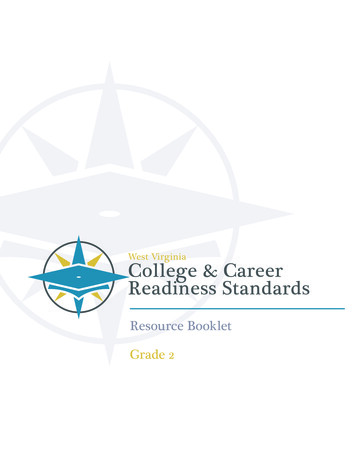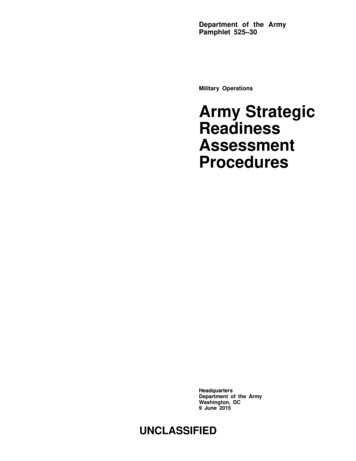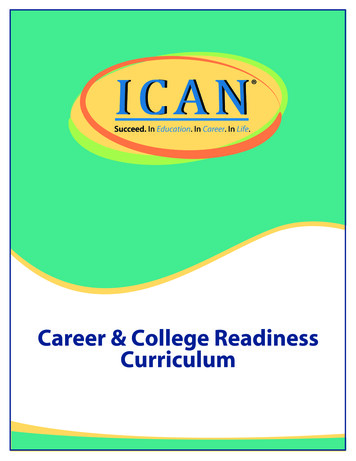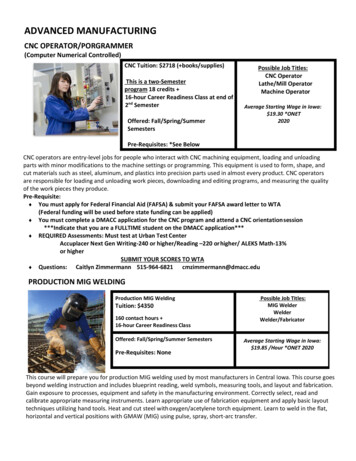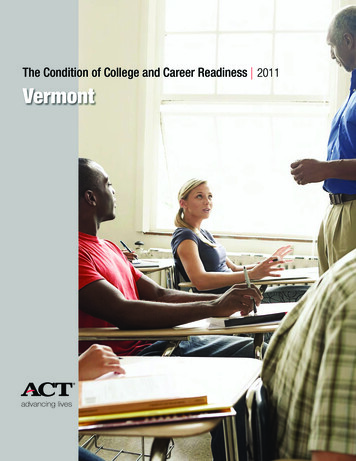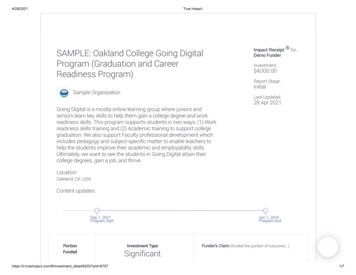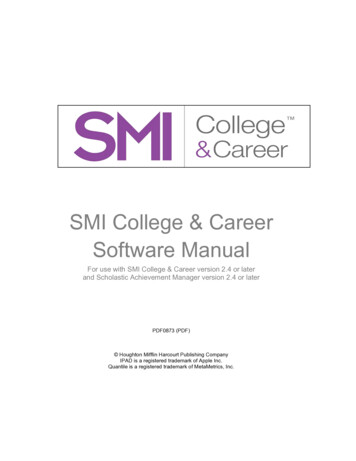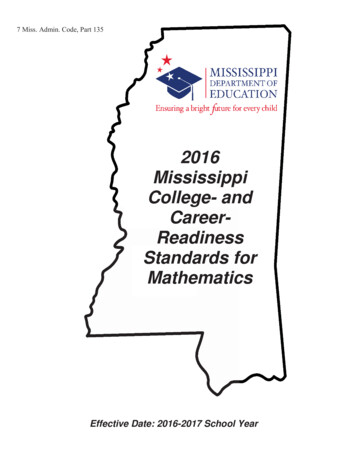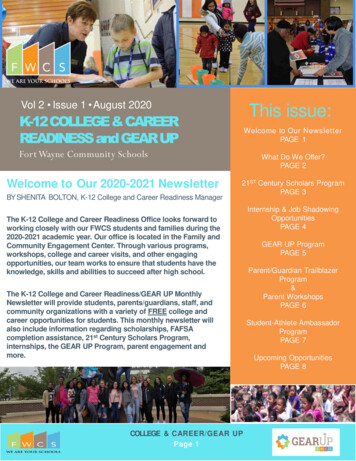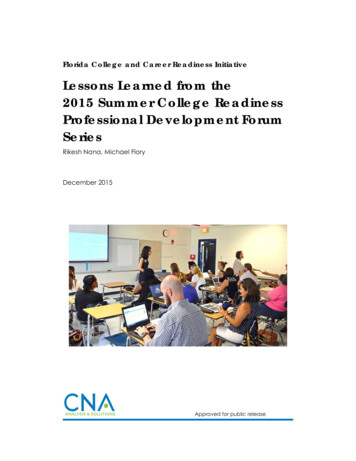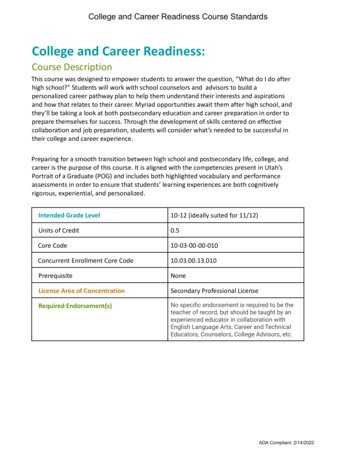
Transcription
College and Career Readiness Course StandardsCollege and Career Readiness:Course DescriptionThis course was designed to empower students to answer the question, “What do I do afterhigh school?” Students will work with school counselors and advisors to build apersonalized career pathway plan to help them understand their interests and aspirationsand how that relates to their career. Myriad opportunities await them after high school, andthey’ll be taking a look at both postsecondary education and career preparation in order toprepare themselves for success. Through the development of skills centered on effectivecollaboration and job preparation, students will consider what’s needed to be successful intheir college and career experience.Preparing for a smooth transition between high school and postsecondary life, college, andcareer is the purpose of this course. It is aligned with the competencies present in Utah’sPortrait of a Graduate (POG) and includes both highlighted vocabulary and performanceassessments in order to ensure that students’ learning experiences are both cognitivelyrigorous, experiential, and personalized.Intended Grade Level10-12 (ideally suited for 11/12)Units of Credit0.5Core Code10-03-00-00-010Concurrent Enrollment Core Code10.03.00.13.010PrerequisiteNoneLicense Area of ConcentrationSecondary Professional LicenseRequired Endorsement(s)No specific endorsement is required to be theteacher of record, but should be taught by anexperienced educator in collaboration withEnglish Language Arts, Career and TechnicalEducators, Counselors, College Advisors, etc.ADA Compliant: 2/14/2022
College and Career Readiness Course StandardsSTRAND 1Students will explore, identify, and evaluate available career pathways usinginterest and aptitude assessments to develop an individualized career pathwayplan.Standard 1 Explore return on investment (ROI), risks/rewards, and the advantages/disadvantages ofdifferent career pathways including postsecondary education, industry certifications,occupational licenses and entrepreneurship/business ownership in this explorationStandard 2 Review, analyze, and update Plan for College and Career Readiness (PCCR) toalign with career pathway plana) Complete and utilize career aptitude assessment to identify careerpathways based on individual interests, values, and skillsb) Investigate career outlook data points to understand projecteddemand the future may hold for various career pathwaysc) Explore the benefits of participating in internship and apprenticeshipprogramsd) Investigate the differences in responsibilities for learning in high schoolversus postsecondary educational settings, highlightingsupport/accommodation structures present in each communitye) Compare and contrast various postsecondary educational optionsincluding technical colleges, community colleges, state colleges, anduniversities and how they interface with for-profit, public, and privatepostsecondary institutionsStandard 3 Evaluate the training/education required for entry into (a) career pathway(s) of choice.a) Identify entry level jobs requiring a HS diploma, on-the-job training,apprenticeships, technical training, and/or a postsecondary degreeb) Compare and contrast differences in jobs requiring different levels of preparationStrand 1 Performance Assessments: Develop a personalized career pathway map that demonstrates how a studenthas taken their interests, aptitudes, and values and ROI into consideration asthey make decisions about their future career
College and Career Readiness Course StandardsSTRAND 2Students will explore postsecondary educational opportunities, includingidentifying resources available to them.Standard 1 Evaluate postsecondary school options and prepare admission criteria for school(s) ofchoicea) Discuss the financial ROI for earning specific postsecondary education credentialsb) Research postsecondary admission requirements, including open and selectiveadmission colleges and universitiesc) Research and discuss postsecondary scholarship requirementsd) Locate dates, times, and resources available to prepare for postsecondary entranceexamse) Identify schools whose characteristics and opportunities align with students’ needsStandard 2 Identify strategies a student can use to succeed at the postsecondary levela) Investigate campus resources (academic, financial, emotional, etc.)available to studentsb) Explore personalized strategies a student can use to deepenunderstanding of course contentStandard 3 Identify financial resources available to all postsecondary studentsa) Research and discuss the options available for covering the costs incurred with apostsecondary education.b) Understand the application process for Free Application for Federal Student Aid(FAFSA)Strand 2 Performance Assessments: Draft a college entrance and/or scholarship essay and receive feedback fromat least two peopleDevelop a rubric for comparing postsecondary institutions (technical andacademic programs offered, size of student population, rural or urban setting,on and off campus housing, extracurricular activities such as sports, cost ofattendance, etc.). Use the rubric to compare at least two postsecondaryinstitutions and identify preferred school(s)Create a personalized portfolio that requires students to be metacognitive,identifying examples of calendering norms, note-taking structures, focusingtechniques and information transfer strategies that are specific to a student’sindividual needs
College and Career Readiness Course StandardsSTRAND 3Students will develop, practice, and demonstrate skills that correlate tosuccessful and collaborative classroom, workplace and life experiences.Standard 1 Develop a set of personalized strategies that correlate to a student reducingrisk factors and enhancing protective factorsa) Explore ways to maintain emotional healthb) Explore ways to maintain physical healthc) Explore ways to maintain social healthd) Identify risk factors experienced by a student and determinestrategies to mitigate the riskStandard 2 Understand how to contribute to a collaborative and inclusive classroomand workplace environment through effective communicationa) Identify the different types of communication that happen within the classroom andworkplaceb) Explore the application of verbal, nonverbal, visual and written communicationstrategies that are effective for an individual in different situationsc) Compare and contrast the differences between personal and professionalcommunication and the consequences of miscommunicationd) Identify and understand the benefits of developing conflict management skills,including the role of active listening, emotional intelligence, impartiality andopen communicationStandard 3 Develop personal accountability and metacognitive skills to promote responsibility,productivity, and agencya) Utilize tools and technologies to maximize time management skillsand increase dependabilityb) Investigate tools and technologies that promote productivityStrand 3 Performance Assessments Research and present on the employability skills that are most relevant to astudent’s career path of choiceCreate a personalized collaboration chart, specifying when differentcommunication patterns/habits are productive and when they are ineffective,including goals the student has regarding improving their own habits
College and Career Readiness Course StandardsSTRAND 4Students will understand the qualifications for success in a particularcareer pathway.Standard 1 Research job openings in a few career pathways of the student’s choice andidentify components needed to applya) Investigate characteristics of an effective resumeb) Investigate characteristics of an effective cover letterStandard 2 Research and engage in action steps to take before, during, and afterjob interviewsa) Research the company and its background before the jobinterviewb) Discuss and identify actions to prepare for the interviewc) Identify effective techniques to use in the job interviewd) Discuss appropriate responses to different interview outcomesStandard 3 Explore how to prepare for a new joba) Understand basic employment forms including W-2s, W-4s and I-9sb) Discuss professional norms prevalent in different workplaces and how to engagewith them effectivelyc) Engage in and reflect on job simulation experiencesd) Compare and contrast common benefit packages including 401(K)s, IndividualRetirement Accounts (IRA), pension plans and tax deferred investments andbasic employee benefitsStrand 4 Performance Assessments: Create a career related profile including a student’s resume, cover letter, andvarious interview responsesBuild a chart comparing the positive and negative aspects of different benefitspackages
align with career pathway plan. a) Complete and utilize career aptitude assessment to identify career pathways based on individual interests, values, and skills b) Investigate career outlook data points to understand projected demand the future may hold for various career pathways c) Explore the benefits of participating in internship and .
